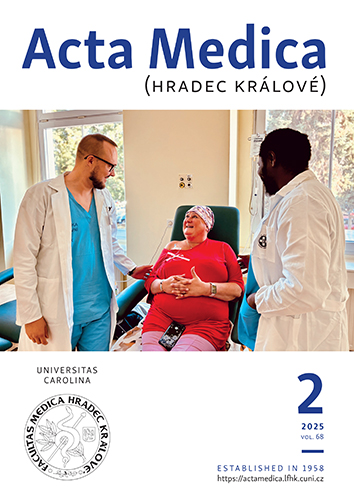ACTA MEDICA, Vol 57 No 2 (2014), 49–55
Radioiodine Treatment of Graves’ Disease – Dose/Response Analysis
Jitka Čepková, Jiří Horáček, Jaroslav Vižďa, Jiří Doležal
zveřejněno: 09. 02. 2015
Abstract
The clinical outcome of 153 Graves’ disease patients treated with a wide dose range of radioactive iodine-131 (RAI) was analyzed retrospectively. Six to nine months after the first dose of RAI 60 patients (39%) were hypothyroid (or rather thyroxine-substituted) and 26 (17%) were euthyroid, while 67 patients (44%) did not respond properly: in 32 (21%) their antithyroid drug (ATD) dose could be reduced but not withdrawn (partial response) and 35 (23%) remained hyperthyroid or the same dose of ATD was necessary (no response). The outcome did not correspond significantly to the administered activity of RAI (medians 259, 259, 222, and 259 MBq for hypothyroid, euthyroid, partial, and no response subgroups, respectively), or the activity retained in the gland at 24 h (medians 127, 105, 143, and 152 MBq). The effect was, however, clearly, and in a stepwise pattern, dependent on initial thyroid volume (17, 26, 33 and 35 ml, P < 0.001) or activity per gram tissue retained at 24 h (6.02, 4.95, 4.75, and 4.44 MBq/g, P = 0.002). Also, higher residual level of thyrotoxicosis at the time of RAI treatment was connected with worse outcome. The dose-dependency of outcome was further analyzed. When our sample was divided into tertiles, according to the adjusted dose, the same modest success rates (47%) were seen in the lower and middle tertiles. However, doses higher than 5.88 MBq/g (the upper tertile) resulted in success rate of 75%. Finer division into decils has shown a threshold-like increase in cure rate between the 7th and the 8th decil. In the first 7 decils (doses ≤ 6 MBq/g) the complete response rate was 45 to 50%, in the 8th decil (6.0 to 7.8~MBq/g) it rose to 80% and was not further increased with increasing dose. Direct comparison of higher (> 6 MBq/g, cure rate 80%) and lower (≤ 6 MBq/g, cure rate 46%) doses gave highly significant difference (P < 0.001). With our dosing range we found a dose-dependent clinical outcome that suggests an optimum delivered dose near 6.5 MBq/g, resulting in successful treatment of ca 80% patients.
klíčová slova: Radioiodine; 131I; Graves’ disease; Hyperthyroidism; Dose/response analysis

Radioiodine Treatment of Graves’ Disease – Dose/Response Analysis is licensed under a Creative Commons Attribution 4.0 International License.
210 x 297 mm
vychází: 4 x ročně
cena tištěného čísla: 150 Kč
ISSN: 1211-4286
E-ISSN: 1805-9694
